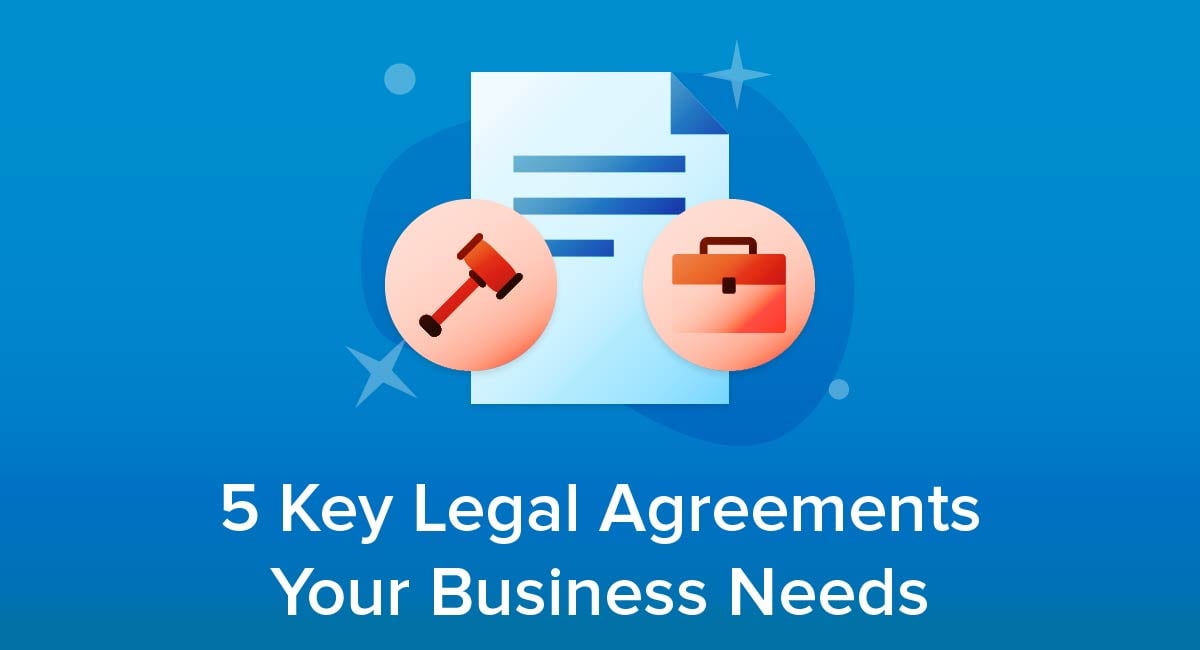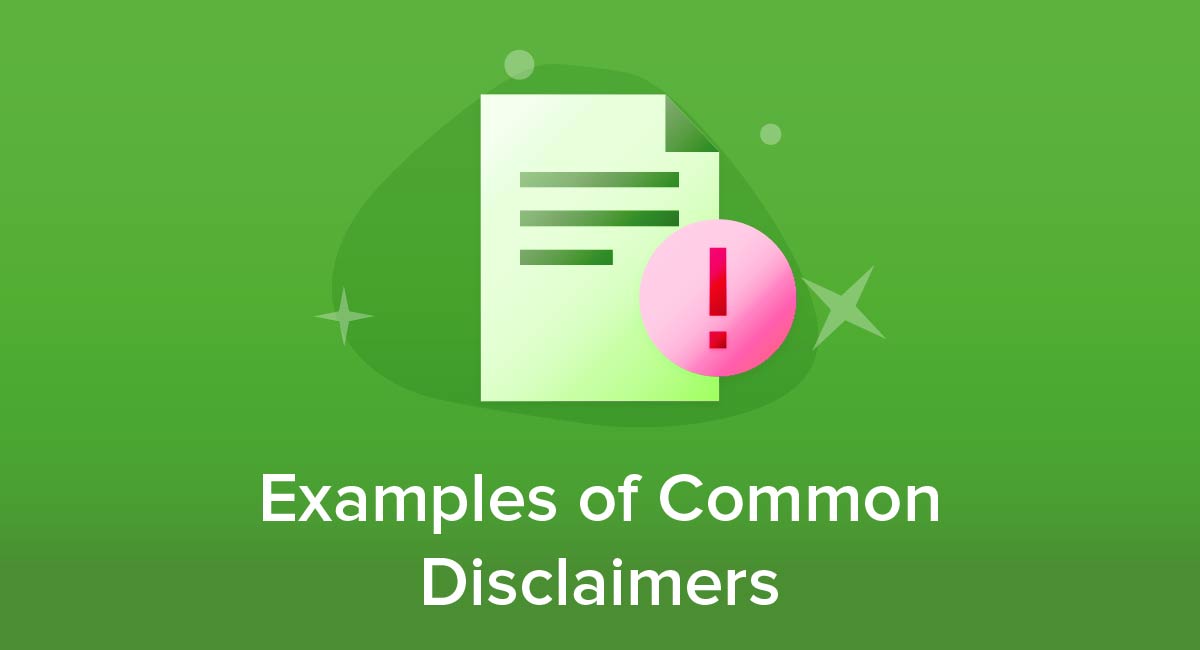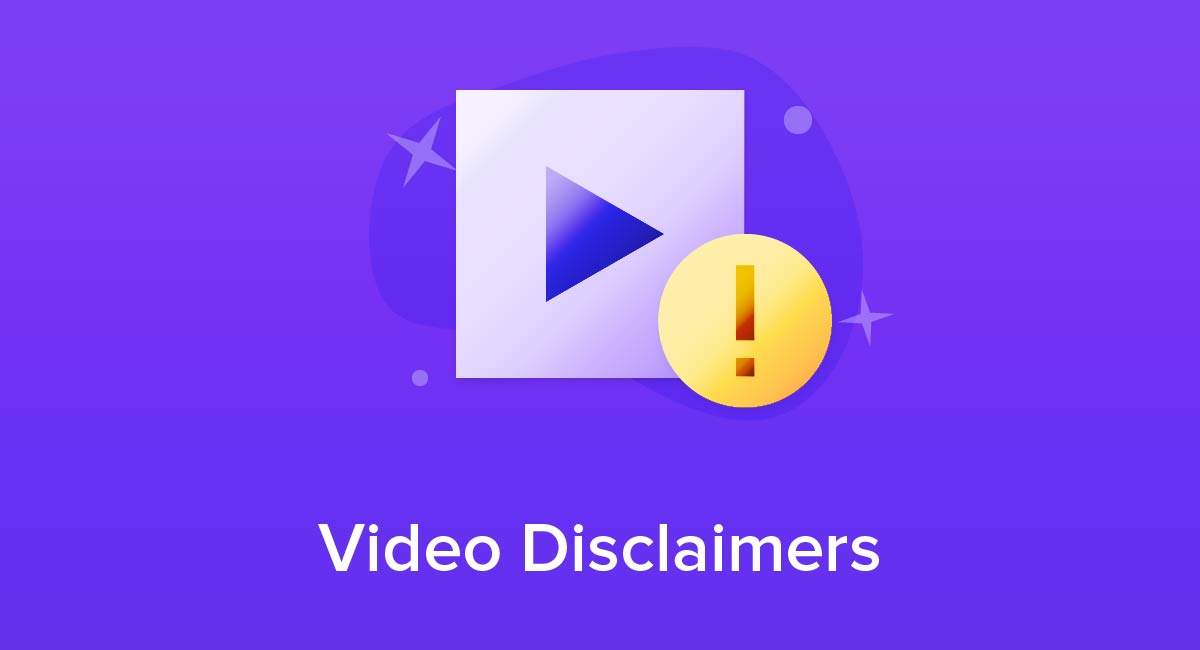
Video Disclaimers are becoming more common and widespread. As website operators and content owners wish to use engaging video content more frequently, there are growing concerns about how users will interpret these videos. A single user mistake can expose you to liability if you are not careful.
That's where video disclaimers come in.
A disclaimer is a short statement that's fairly easy to draft. It will inform users and limit your responsibilities and liability. It will also offer you protection from the misuse of your information.
Here's why you should add a video disclaimer, an overview of different types of disclaimers, and tips for drafting them.
Importance of Disclaimers
Disclaimers are legal statements that advise users of rights, risks, and liabilities that may be associated with accessing content. Currently, they are more common with static content like web pages and blogs.
However, they are gaining popularity with website and YouTube videos. Content owners realize that the persuasive power of videos may lead to liability against them for the information and content they share in their videos.
To protect themselves, content owners may provide disclaimers in order to:
- Inform users - If a video shows content that is not typical of usual experiences, a disclaimer can address that fact. For example, an investment firm may feature a testimonial that reflects a customer who enjoyed above-average success with one of the firm's strategies. A disclaimer here would let viewers know that not everyone will experience the same above-average level of success with the firm's strategies.
- Reduce liability - Since videos are engaging, many users may watch one and take the presentation as professional advice. A disclaimer can indicate that the video does not form a professional relationship between the company and the viewer, and that the best course of action is to consult with a professional. Also, indicating in a disclaimer that an activity is dangerous, or that warranties may not apply also serve to reduce liability.
- Disclose affiliates - If the video is associated with any affiliate relationships, those connections may be disclosed in an affiliate disclaimer. That is often required by law and failing to disclose those relationships may result in fines from the Federal Trade Commission (FTC).
- Control interaction - If a video is posted on a YouTube channel, the disclaimer may offer an additional function. YouTube channels allows comments and encourage interaction between users. Operators may use the disclaimer to set out rules for these comments and express their right to delete comments that are off-topic, harassing or offensive.
You may need a video disclaimer for all of the reasons above or just one of them.
Types of Video Disclaimers

The purpose for the disclaimer defines the type of disclaimer you need to draft.
Video disclaimers are short and customized to their content. Generally, they fall under one of the following types:
- General liability protection
- Professional liability protection
- Copyright protection statements
- Content control rules
- Earnings disclaimers
- Warnings
General liability waiver
If your content is not specific to professional liability and does not necessarily promote anything risky, you will likely benefit from a general liability waiver. This will work as a general release from liability and a waiver of inferred warranties.
These disclaimers start by explaining that the content owner intends to present accurate information. However, it refuses to guarantee results or make warranties as to success or safety. Any risk remains solely with the user and how they interpret the video information.
Global Virtual Opportunities is a video conference provider that also offers marketing information. Videos advise users of best practices for getting the most out of the platform and their conferences.
As a precaution, Global Virtual Opportunities waives warranties and will not assume liability if their platform does not bring the intended results. This protects the company if users don't get the results they expect:
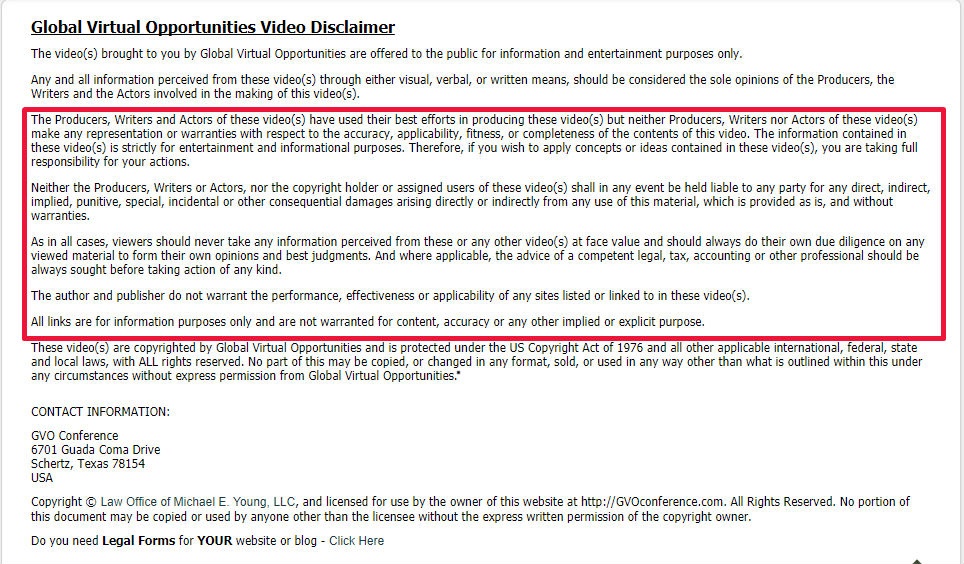
If you are concerned about risk, having users accept the disclaimer before proceeding is a good move. While this isn't very common, it does happen.
Here's an example.
Lochinvar sells heating and cooling equipment and the website offers instruction videos for its technicians. Since this information may be misused by consumers who lack training, it requires affirmative consent to the disclaimer before the user can access these videos:
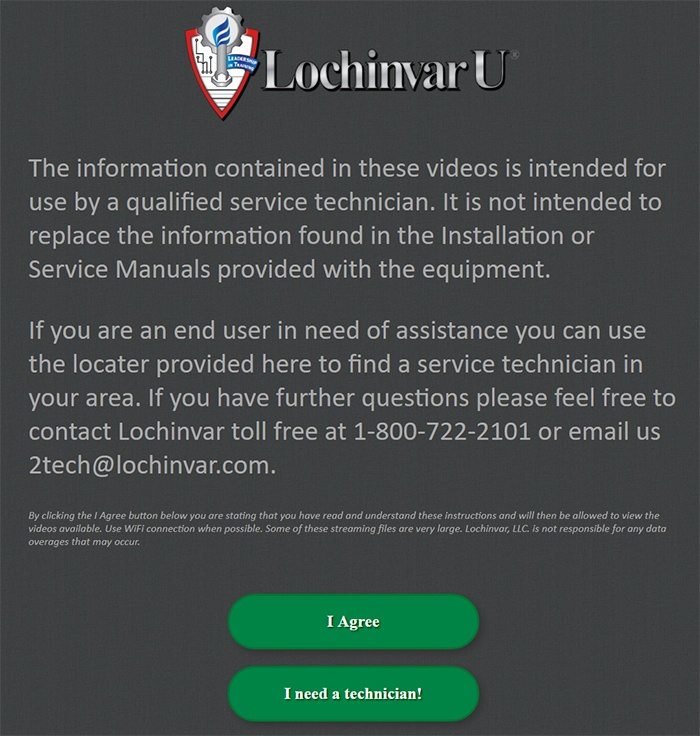
Professional liability waiver
The professional liability waiver limits liability, but it also addresses specific risks faced by a profession. Doctors, lawyers, and financial professionals may offer informational videos and users may be tempted to rely on them rather than schedule a consultation. The video disclaimer in these instances waive liability and inform users that the video is not meant to replace professional advice.
Harvard Medical School presents several videos on health issues. Its video disclaimer waives warranties much like a general liability waiver, but also emphasises professional liability by stating the videos are not professional advice:
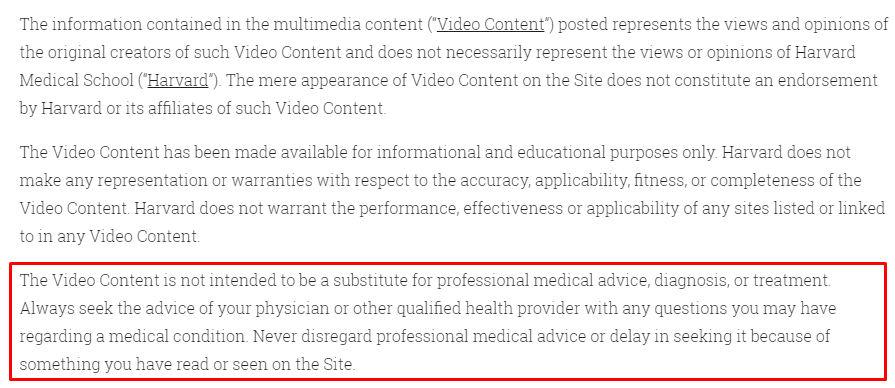
Professional liability video disclaimers are most common with healthcare providers and information services. This practice has not caught on yet with other professionals, like lawyers and financial advisors. If you are in these fields or creating content for a client in one of these fields, adding a disclaimer is a good precaution even if it is not a widespread practice yet.
Copyright protection statement
Websites are entitled to copyright protection. This includes unique videos you use for advertising or teaching.
Besides your own copyrighted material, you may also use content that belongs to another company or individual. It is likely that this use falls under the Fair Use doctrine.
This legal concept allows limited use of another individual's copyrighted material as long as the final product is unique enough so to not be confused with the original creation. If an organization partakes in fair use, sometimes a video disclaimer will mention that right.
However, it's disputed whether a fair use statement in your disclaimer will excuse you from liability. At best, this statement shows you intend to avoid infringing on another's copyrighted material.
If you are concerned about copyright infringement, your video disclaimer should contain elements that protect your copyrighted material and right to fair use. Including both covers more ground and emphasizes your intention to create unique material.
Convoy of Hope has a strong copyright protection statement in its video disclaimer. It explains that first, it takes photographs and videos of events. Second, it allows a waiver if someone does not want their material online, and finally, it emphasizes its own copyrights in its work:
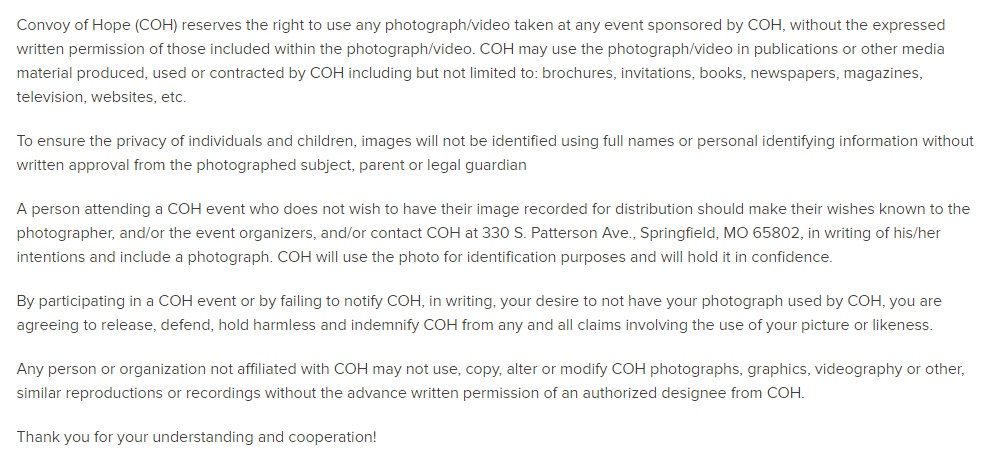
You'll likely want a similar disclaimer even if your work depends entirely on fair use. Most derivative works are considered unique works of art and that would give them separate copyright protection. Including both statements makes your intentions to avoid infringement clear while also emphasizing your ownership rights.
Content control rules
If the video is presented on a YouTube channel, the content owner may allow comments. This means that there will be a risk of harassment between users, inappropriate comments about the product or services being discussed, and off-topic content that detracts from the video's message.
In this context, the video disclaimer acts like a separate Terms & Conditions for a content owner's channel.
Bernard restricts comment material by including this in its video disclaimer. It has a multi-pointed list of what users are not allowed to do when on Bernard's YouTube page:
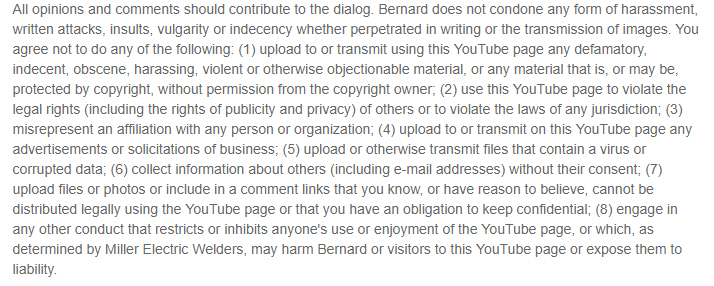
It also reserves the right to edit or delete anything it feels is inappropriate, as well as terminate user access to its YouTube page:

If you allow user interaction with your videos on YouTube or your website, include these rules in both your Terms & Conditions and video disclaimer. That enhances your enforcement powers so you can maintain the most productive online environment possible.
Earnings disclaimer
Websites featuring profit systems or investment tips are required by the FTC to contain earnings disclaimers. If your earnings website also teaches users through videos, it is a good idea to include an earnings disclaimer in your video disclaimer language.
Some of these disclaimers are similar to the professional liability one described above. It may include warning users to speak with an accountant or investment adviser first. However, the emphasis is on informing consumers that they are taking a risk.
Halter Ferguson Financial offers investment products. Its video disclaimer contains a provision that results are not guaranteed and all investment strategies contain risk:

Since earnings disclaimers are required by the Federal Trade Commission, erring on the side of overkill is reasonable. It does not take much effort to add this statement to your video disclaimer even if you have a visible earnings disclaimer. At the least, add a link to your earnings disclaimer in your video description.
Warnings
Some videos depict inherently dangerous activities. Extreme sports probably come to mind, but more simple things could also fall under this category. Home repair projects involving ladders or electrical repair, for example, could also prove dangerous to users.
If this is the case with your material, your video disclaimer should focus on warning users.
American Mountain Guides Association includes a two-part disclaimer that recognizes the dangers of mountaineering. The first part of its disclaimer reminds users of risks and advises that they consult with an experienced guide before trying anything depicted in the video:
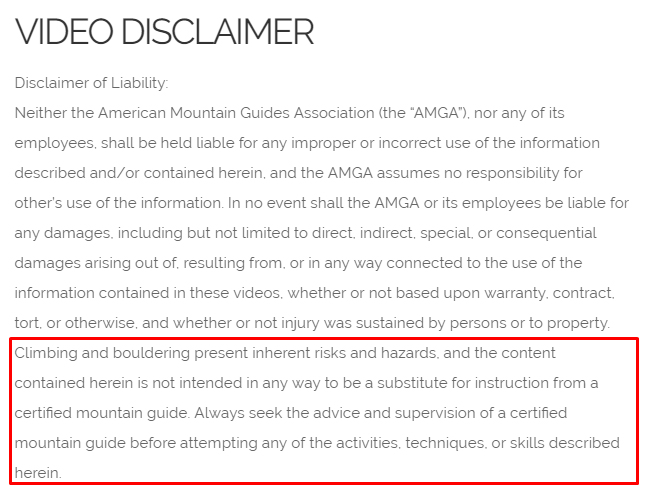
The second part is a warranty disclaimer. It generally states that the information is accurate to the best of the company's knowledge but users should rely on it at their own risk:

Many video disclaimers contain "use at your own risk" language but the example here is more comprehensive. It is a good combination that warns of risk while also recommending professional guidance. You would do well to take the same approach.
Drafting Tips

Video disclaimers take many forms. You may want to use a combination of the examples above. However, keep in mind that these disclaimers are meant to be short. You do not want a video disclaimer to rival your Terms & Conditions or Privacy Policy.
Keeping them concise adds to their effectiveness. Users are more likely to read a short disclaimer than yet another long agreement.
To draft the best disclaimer for your online videos, take the following steps:
- Imagine the worst case scenario - What is the worst that can happen if a user takes your video literally? That helps determine the focus of your disclaimer. For example, if you offer financial advice on a website, the worst case scenario may involve a user misinterpreting your video and losing her life savings. In that case, you may wish to focus on an earnings disclaimer and warning about risk. If you allow user interaction in a comments section, it is likely you need rules of conduct and a right to remove comments.
- Assess your copyright concerns - For content that merely exists to entertain, your worst case scenario may be copyright infringement - either suffering it or being accused of it. If that's a concern, your video disclaimer should center around issues of copyright protection and fair use.
- Use simple terms - Just as with your other online agreements, you want users to comprehend the video disclaimer. Draft them using common language and lay terms to reduce misunderstanding.
- Keep them brief - As mentioned above, video disclaimers should be short in order to be effective. The whole disclaimer should be seen on one web page with no scrolling required.
- Make them accessible - Consider providing a link to your video disclaimer in the video description. Another approach is to require acceptance of the disclaimer before the user accesses the video. The Lochinvar U link example above shows you how to accomplish that.

